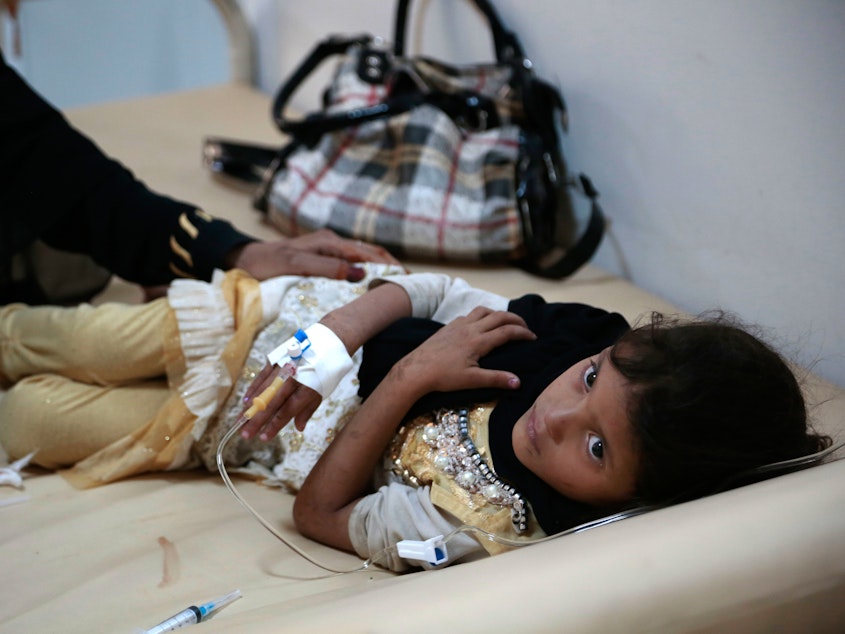The Health Of The World In 2018, By The Numbers

At year's end, global health numbers offer reason for both hope and despair.
There is one strong positive note. An overriding public health finding is that people are living longer. "If that's not a bottom line reason for optimism," says Dr. Ashish Jha, director of the Harvard Global Health Institute and the T.H. Chan School of Public Health, "I don't know what is."
And then there are the million-plus cases of cholera in Yemen — deemed "a hideous milestone for the 21st century" by the International Committee of the Red Cross.
Note: Because of the way global numbers are gathered, it's too soon to report on health statistics from the year now drawing to a close. There are only a few yet available for 2018 — polio cases, for example, and Ebola deaths in Democratic Republic of the Congo.
But there has been a constant stream of numbers released from the years just past. Unless otherwise noted, the numbers below represent the worldwide population.
Sponsored
Life Expectancy
Worldwide life expectancy in 2016 was 72 years, up from 66.5 years in 2000.
The gain of 5.5 years in worldwide life expectancy between 2000 and 2016 was the fastest gain since the 1960s and reversed the declines of the 1990s caused by AIDS in Africa and the fall of the Soviet Union.
But life expectancy has been ticking down in the U.S. for three years: it was 78.9 in 2014; 78.8 in 2015; 78.7 in 2016; and 78.6 in 2017. An increase in deaths from opioids and from suicide is a possible reason for the trend.
Child mortality rates for children under five years of age have fallen from 216 deaths per 1,000 live births in 1950; to 93 deaths per 1,000 life births in 1990; to 40.5 deaths per 1,000 in 2016; and most recently to 39.1 deaths per 1,000 live births in 2017.
Sponsored
Health Care
3.6 million people died in 2016 because they had no access to health care.
5 million people, despite having access to health care, died in 2016 because the quality of care they received was poor.
In 2010, the year that the Affordable Care Act was signed into law, 49.9 million people in the United States, or 16.3 percent of the population under age 65, were without health insurance. In 2017, that number dropped to 28.9 million uninsured, or 10.7 percent of that segment of the population.
Yet also in 2017, the number of uninsured Americans increased by nearly half a million — the first increase since the Affordable Care Act was implemented.
Sponsored
HIV/AIDS
36.9 million people were living with HIV in 2017.
940,000 people died of AIDS-related illnesses in 2017.
35.4 million people have died from AIDS-related illnesses since the epidemic was identified in 1981.
Ebola
Sponsored
11,325 people died of Ebola in the epidemic of 2014-2016 in West Africa.
As of Dec. 23, there have been 347 confirmed deaths so far in the current Ebola outbreak in the Democratic Republic of Congo.
Air Quality
Pollution contributed to the deaths of some 9.9 million people in 2015 by causing diseases such cancer, heart disease and respiratory illnesses. That's three times more deaths than the death toll from AIDS, tuberculosis and malaria combined.
Murder
Sponsored
Roughly 385,000 people were murdered around the world in 2017.
Hunger
Some 821 million people around the world did not get enough to eat in 2017. resulting in malnutrition, and about 151 million children under five experienced stunted growth due to malnutrition.
An estimated 1.9 billion adults were overweight or obese in 2016. 41 million children under five are overweight or obese.
Cholera
There were 1,207,596 suspected cases of cholera in Yemen between April 2017 and April 2018.
The total estimated number of cholera cases worldwide ranges from 1.4 million to 4 million.
Vaccinations
Global vaccination rates against childhood diseases in 2017: 85 percent. That number has stayed steady for several years.
In 2017, about 100,000 children in the U.S. under two, or 1.3 percent of children that age, had not been vaccinated against serious diseases like measles and whooping cough.
The percentage of unvaccinated U.S. children has quadrupled from 0.3 percent in 2001 — shortly after the circulation of erroneous and disproven reports that vaccines cause autism.
Polio
The number of cases of polio worldwide in 2018 as of Dec. 25 was 29, compared to 22 in 2017. There were an estimated 350,000 cases around the world in 1988.
A mysterious polio-like disease, called acute flaccid myelitis that can paralyze patients, mostly children, appeared in the U.S. in 2014 with 120 confirmed cases from August to December. There were 22 confirmed cases in 2015, 149 confirmed cases in 2016, 35 confirmed cases is 2017 and 182 cases as of Dec. 21, 2018.
Guinea Worm
In 1986, guinea worm disease, an incapacitating disease that creates painful lesions, affected some 3.5 million people in Africa and Asia. As of Oct. 1, 2018, there were 25 reported cases of guinea worm disease worldwide: 1 in Angola; 14 in Chad, and 10 in South Sudan. One obstacle to wiping it out entirely: The worm can circulate in dogs.
Mystery Disease
Number of cases of Disease X: Zero. But that doesn't mean the World Health Organization isn't worried about it. They use the term Disease X to refer to a pathogen "pathogen currently unknown to cause human disease" but that has the potential one day to trigger a deadly pandemic.
Susan Brink is a freelance writer who covers health and medicine. She is the author of The Fourth Trimester, and co-author of A Change of Heart. [Copyright 2018 NPR]



